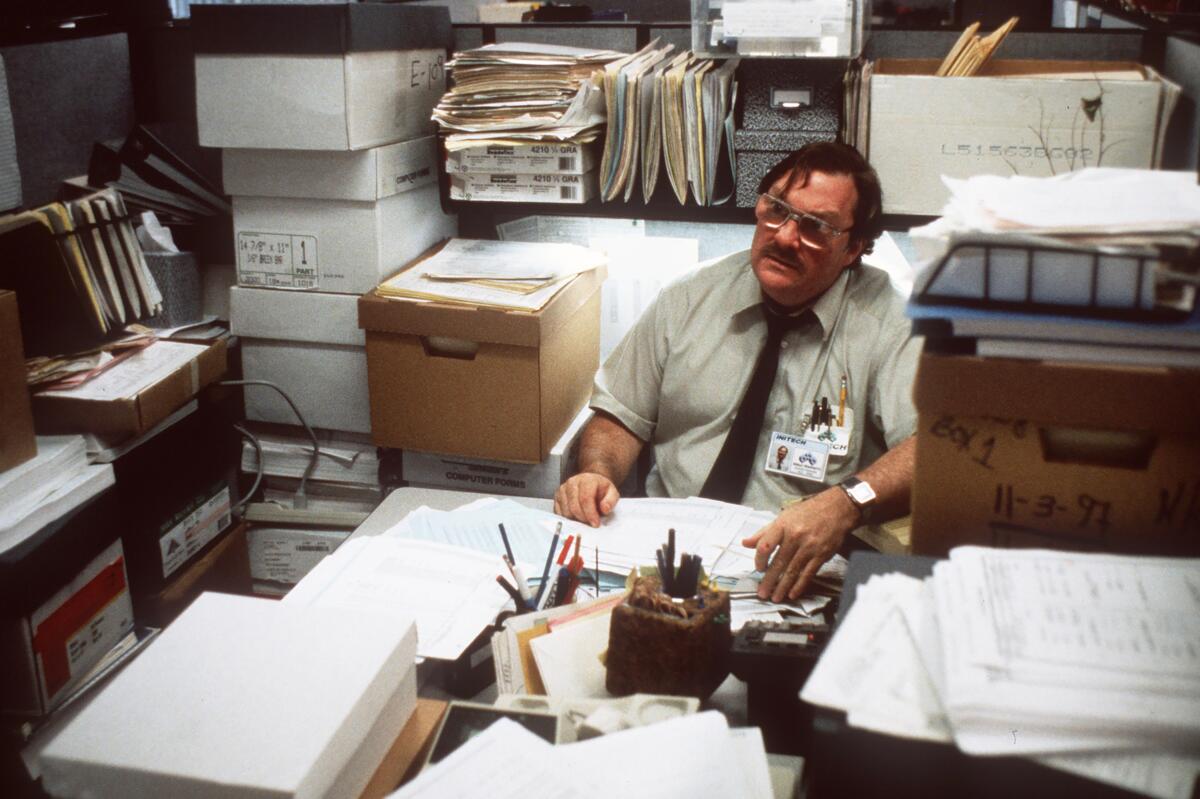Gen Z didn’t coin ‘quiet quitting’ — Gen X did

- Share via
American business leaders sometimes talk about workforce productivity trends the same strained way you might expect a perfectly healthy hypochondriac to check his body temperature three times a day. (Remember “nobody wants to work anymore”? The U.S. unemployment rate is 3.5%.) The new social media meme about “quiet quitting” — not actually quitting, but doing the bare minimum at your job — is the latest vascular twinge to send CEOs back to the carpet with two fingers to the neck, checking for skipped heartbeats.
“Quiet quitting clearly entered our work conversation, but here’s why we need to keep it out of our work lives,” famous boss Arianna Huffington, chief executive of Thrive Global, fretted in a LinkedIn essay last week. “Quiet quitting isn’t just about quitting on a job, it’s a step toward quitting on life.”
But once you exit the leather sofa inside LinkedIn’s glass office and stop by the open-plan bullpen of TikTok, it’s clear that the rank-and-file is quite open to the idea of a lighter workload. In a series of skits by user Sarai Marie that has accumulated more than 1 million likes, a character named Veronica plays out “quiet quitting.” “OK let’s see, goal for today — 500 calls?! We’re doing 50,” the character says, later telling a boss: “Respectfully, Susan, it’s 2022; we’re acting our wage, so don’t give me extra work.” She clocks out at precisely 5 p.m.
Anti-work sketch comedy on TikTok has become something like the sea shanty of the Zoom era. It’s a communal art form by and for an increasingly self-confident workforce, which knows it’s gotten an unusual upper hand on employers due to the historically tight labor markets of the late Trump and early Biden administration years.
Comedian (and former IKEA customer service employee) Scott Seiss repeatedly went viral last year with a series of videos in which he played a disgruntled worker roasting irritated shoppers. “You think you hate this place more than me? I work here!” Seiss asks over a soundtrack of dramatic music. Creators like @loewhaley repeatedly role-play scenarios showing an employee avoiding a manager trying to impose unpaid overtime; the recurring punchline is that the worker refuses to succumb to wage theft. It’s humor, but not exactly a laugh line.
Strivers, grinders and hustlers hate them, but quiet quitters, slackers and work-to-rulers are treasured antiheroes in American folk culture.
In Herman Melville’s 1853 short story “Bartleby, the Scrivener,” a Wall Street clerk bewilders his manager by politely refusing to do basic tasks, including leaving the office. “I would prefer not to,” Bartleby says. “You will not?” his boss asks. “I prefer not,” affirms Bartleby. In a country obsessed with profits, productivity and becoming the boss of other people, Bartleby remains American literature’s patron saint of insubordination. “I would prefer not to” has been immortalized on anti-motivational coffee mugs and T-shirts, our merch of quiet desperation.
Coasting counterculture reached its true boom days in the 1990s, which were dotted with underachiever fare like “Slacker,” “Clerks,” “The Big Lebowski” and “Wayne’s World.” While the dot-com bubble was giving us rock-star tech CEOs, the 1999 film “Office Space” explored the box-checking cubicle hell populated by their underlings. Peter, a spiritually tortured everyman played by Ron Livingston, is transformed via accidental hypnosis into a carefree straight-shooter, suddenly immune to the minor humiliations and tedious managing-up of corporate life. His honesty about zoning out at his desk and hiding from his supervisors shocks the outside consultants, both named Bob, who had been sizing him up for layoff.
“My only real motivation is not to be hassled; that, and the fear of losing my job,” Peter tells them. “But you know, Bob, that will only make someone work just hard enough not to get fired.” In the film’s most inspired twist, the consultants decide Peter has upper-management potential, somebody who could be energized by a nice employee stock-option plan.
“Office Space” initially bombed at the box office, but not with Kelly Love Johnson, 42, chief content officer for Workology.com. She was one of the few to see it on the big screen but one of the many who recognized Peter’s fictional story as her own reality, the sort of shock of recognition that turned the film into a cult classic. After starting her first job at 15 and working herself to exhaustion for five years at a tech company while putting herself through school, Johnson’s spirit finally broke. Johnson kept showing up to work, but she stopped going above and beyond. It felt radical, and so was what happened next.
“Once I did mentally quit, nobody noticed,” Johnson said. “I was putting 50% of my energy into just doing what’s in my job description, and no one noticed. I continued to get promoted, I continued to get raises, I continued to get things added to my job description.”
In her 2008 book “skirt! Rules for the Workplace: An Irreverent Guide to Advancing Your Career,” Johnson coined a term for her experience, “quitting in place,” which gained traction with some human resources experts. Johnson’s term recently appeared in a Business Insider story on “coasting culture” in March by Aki Ito, which described how many overextended employees “have quietly decided to take it easy at work rather than quit their jobs.”
The Insider story appears to have inspired the first known use of “quiet quitting,” by career coach Bryan Creely, 44, of Nashville, Tenn., who went on TikTok and YouTube on March 4 to riff on the Insider story. After being laid off during the onset of the pandemic in 2020, Creely, a longtime corporate recruiter, started posting videos giving advice on how to apply for jobs and how to navigate work problems. He was interested by people who were rebelling against “toxic work environments” and long hours by putting in the minimum instead of quitting.
“Those of us who grew up in hustle culture, where you have a constant, incessant need to work, work, work — and work becomes the main priority of your life to get ahead — I think that has taken a seismic shift over the last year to year and a half,” Creely’s original video said. “Are you somebody that has quiet quit on the job? Let me know in the comments below.”
Creely’s coinage appears to have been accidental. “I just blurted it out,” Creely said in an interview, not realizing he was the apparent first to use the term until The Times contacted him. “I feel a little weird taking credit for it.”
Although the facts show that the term “quiet quitting” is a Gen X creation, Creely said his videos about the concept have resonated with viewers of all ages. He recommends employers embrace more realistic workloads, and he also recommends workers head toward jobs where they’ll be happier in the long run.
“It clearly has struck a chord,” Creely said. “The quiet quitting, quitting-in-place, whatever you want to call it — I suspect people have probably been doing it for a long time, and they didn’t have a term for it.”
More to Read
The biggest entertainment stories
Get our big stories about Hollywood, film, television, music, arts, culture and more right in your inbox as soon as they publish.
You may occasionally receive promotional content from the Los Angeles Times.











